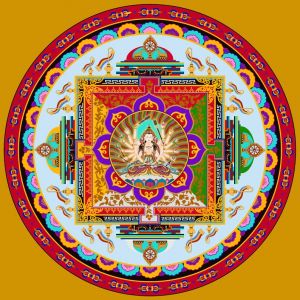ཀུན་ལ་མཁོ་ཆེ་བའི་མཎྜལ་སོ་བདུན་མ་ཚོམ་བུ་འགོད་ཚུལ་དཔེ་རིས་དང་བཅས་སོ།། What is Mandala?
What is Mandala?
Although often associated with Eastern religions, the mandala, which is derived from the words for container (la) and essence (manda), has been used as a powerful symbol since early civilisations in ceremonial rituals and as an aid to worship, or meditation.
A mandala is a representation of the cosmic, the universe, in a circular pattern which leads to a central point. As such, it is a symbol or wholeness, of beginning and end.
Simple mandala have been drawn by many native people in many counties, including the early Australian Aboriginal people. Many Christian churches have a circular stained glass window, with the cross as the centre point of the circle.
In Buddhist mandala, the circles represent levels of the cosmos, and the squares generally depict earthly levels. The levels may have gates, which lead into the centre of the mandala.
The mandala is used as an external expression to help find the universe within. Often, the mandala incorporates symbols or physical representations of the Buddha to show the transition of the spiritual journey.
The mandala represents an imaginary palace that is contemplated during meditation. Each object in the palace has significance, representing an aspect of wisdom or reminding the meditator of a guiding principle.
